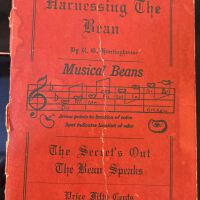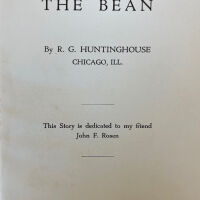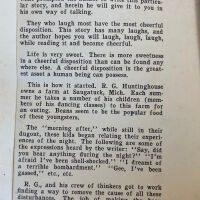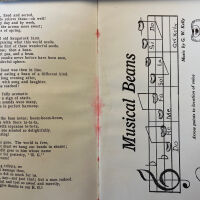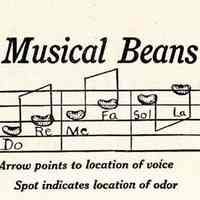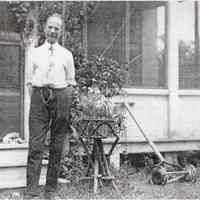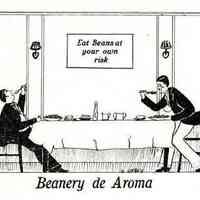Harnessing the Bean

2011.17.05
Chicago Dance Master R. G. Huntinghouse (1861-1954) (see Jun. and Aug. 2010 SDHS Newsletters) was not just a great terpsichorean, but also quite a wit. In 1931 he published a small booklet entitled "Harnessing the Bean" which dealt with neutralizing the aromatic and sonic after effects of a meal of beans. The SDHS has a digital copy of this rare work. How did it come to be written? As the owner of a farm in Saugatuck at the northeast corner of South Maple and Old Allegan, "Each summer he takes a number of his children (members of his dancing classes) to this farm for an outing. Beans seem to be the popular food of these youngsters. The "morning after," while still in their dugout, these kids began relating their experiences of the night. The following are some of the expressions heard by the writer: "Say, did you hear anything during the night?" "I'm afraid I've been shell-shocked." I dreamt of a terrible bombardment." "Gee, I've been gassed," etc., etc." "R.G., and his crew of thinkers got to work finding a way to remove the cause of all these disturbances." And thus the book began to be constructed. R.G. writes of the formation of "THE NOISELESS, ODORLESS, PERFUMED AND MUSCIAL BEAN CO." with officers including: A. Low Rumble; Rose Fragrance; R. U. Sniffing; O. Sweet O'Dore; and Violet Toots. Capital "1,000,000 scents", organized with the aim "to produce noiseless, odorless, perfumed and musical beans, and give the bean something to live for, and make our life worth living too." He goes on to write of many wonderful new species of bean he was to breed on his farm, to include: musical bean; conversational bean; lullaby bean; short-circuited bean; saxophone bean; non-skid bean; and the sound-proof bean--- "A BOON TO GOLF PLAYERS"- "The sound-proof bean has been especially cultivated to meet a demand for total abstinence of noise during a game of golf. These beans, as we grow them on our noiseless, aromatic and musical bean farm at Saugatuck, Mich., will entirely revolutionize the cultivation of beans. All old fashion beans will now go into the discard." ---"On the experimental farm at Saugatuck, Mich., we are working on a giant bean developed into a fog horn. This we plan to sell to the government for signal stations." ---"With the introduction of the perfumed, or odorless bean, there will be no further need of a hostess providing her guests with clothes pins when entertaining at card parties, or other social gatherings." "Ungainly, and unattractive signs, formerly hanging over a dining room table "eat beans at your own risk," can now be removed." As a part of the forward to this booklet, local boy Charles Samuel Dailey, then 26, penned a 13 stanza tribute entitled "Ode to R.G. Huntinghouse", which ends: So in loving tribute, we ---Pay just homage thus, To one who did so much for us, ---A name, nay - not just that; but a man indeed. So as we eat and toot so sweet and merrily, ---Let us all give thanks to our R.G! Dailey (1904-1949) had been born in the family home on Richmond Road (Old Allegan now) moved with the family to Oregon, only to return to live at "Slumber Bluff" (later to be called "Oak Openings.") He was a 1923 graduate of Saugatuck High School (and senior class president), went on to attend the Milwaukee School of Engineering, and in 1925 began sailing the Great Lakes on the steamer "Harvester". He was later to receive Captain papers. Submitted by Chris Yoder, August 2011. A full copy of this scientific work of humor can be found on the society web site at: http://sdhistoricalsociety.org/SDHSWeb/MiscFiles/RGHuntinghouse-HarnessingtheBean.pdf
Biographies and personalities
Huntinghouse, Rudolph G. 1861-1954
1931
Files Accession Number
Yaksic/Burns/Huntinghouse houseHuntinghouse, Rudolph G. 1861-1954
04/11/2011
01/12/2024

